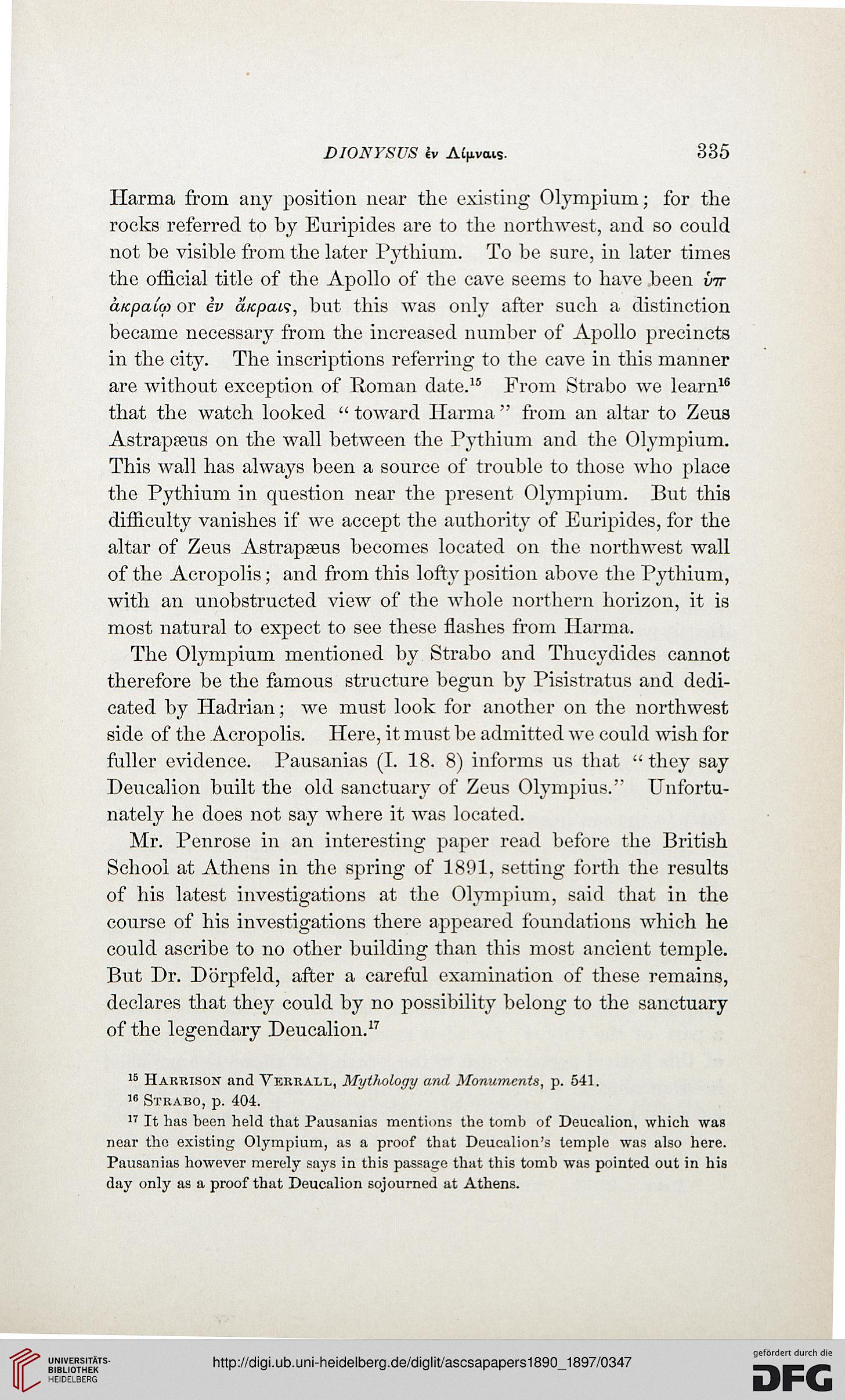DIONYSUS h A£(ivcus.
335
Ilarma from any position near the existing Olympium; for the
rocks referred to by Euripides are to the northwest, and so could
not be visible from the later Pythium. To be sure, in later times
the official title of the Apollo of the cave seems to have been vtt
afcpa(o) or ev a/cpais, but this was only after such a distinction
became necessary from the increased number of Apollo precincts
in the city. The inscriptions referring to the cave in this manner
are without exception of Roman date.15 From Strabo we learn16
that the watch looked " toward Ilarma " from an altar to Zeus
Astrapseus on the wall between the Pythium and the Olympium.
This Avail has always been a source of trouble to those who place
the Pythium in question near the present Olympium. But this
difficulty vanishes if we accept the authority of Euripides, for the
altar of Zeus Astrapaeus becomes located on the northwest wall
of the Acropolis; and from this lofty position above the Pythium,
with an unobstructed view of the whole northern horizon, it is
most natural to expect to see these flashes from Ilarma.
The Olympium mentioned by Strabo and Thucydides cannot
therefore be the famous structure begun by Pisistratus and dedi-
cated by Hadrian; we must look for another on the northwest
side of the Acropolis. Here, it must be admitted we could wish for
fuller evidence. Pausanias (I. 18. 8) informs us that " they say
Deucalion built the old sanctuary of Zeus Olympius." Unfortu-
nately he does not say where it was located.
Mr. Penrose in an interesting paper read before the British
School at Athens in the spring of 1891, setting forth the results
of his latest investigations at the Olympium, said that in the
course of his investigations there appeared foundations which he
could ascribe to no other building than this most ancient temple.
But Dr. Dorpfeld, after a careful examination of these remains,
declares that they could by no possibility belong to the sanctuary
of the legendary Deucalion.17
15 Harrison and Verrall, Mythology and Monuments, p. 541.
16 Strabo, p. 404.
17 It has been held that Pausanias mentions the tomb of Deucalion, which was
near the existing Olympium, as a proof that Deucalion's temple was also here.
Pausanias however merely says in this passage that this tomb was pointed out in his
day only as a proof that Deucalion sojourned at Athens.
335
Ilarma from any position near the existing Olympium; for the
rocks referred to by Euripides are to the northwest, and so could
not be visible from the later Pythium. To be sure, in later times
the official title of the Apollo of the cave seems to have been vtt
afcpa(o) or ev a/cpais, but this was only after such a distinction
became necessary from the increased number of Apollo precincts
in the city. The inscriptions referring to the cave in this manner
are without exception of Roman date.15 From Strabo we learn16
that the watch looked " toward Ilarma " from an altar to Zeus
Astrapseus on the wall between the Pythium and the Olympium.
This Avail has always been a source of trouble to those who place
the Pythium in question near the present Olympium. But this
difficulty vanishes if we accept the authority of Euripides, for the
altar of Zeus Astrapaeus becomes located on the northwest wall
of the Acropolis; and from this lofty position above the Pythium,
with an unobstructed view of the whole northern horizon, it is
most natural to expect to see these flashes from Ilarma.
The Olympium mentioned by Strabo and Thucydides cannot
therefore be the famous structure begun by Pisistratus and dedi-
cated by Hadrian; we must look for another on the northwest
side of the Acropolis. Here, it must be admitted we could wish for
fuller evidence. Pausanias (I. 18. 8) informs us that " they say
Deucalion built the old sanctuary of Zeus Olympius." Unfortu-
nately he does not say where it was located.
Mr. Penrose in an interesting paper read before the British
School at Athens in the spring of 1891, setting forth the results
of his latest investigations at the Olympium, said that in the
course of his investigations there appeared foundations which he
could ascribe to no other building than this most ancient temple.
But Dr. Dorpfeld, after a careful examination of these remains,
declares that they could by no possibility belong to the sanctuary
of the legendary Deucalion.17
15 Harrison and Verrall, Mythology and Monuments, p. 541.
16 Strabo, p. 404.
17 It has been held that Pausanias mentions the tomb of Deucalion, which was
near the existing Olympium, as a proof that Deucalion's temple was also here.
Pausanias however merely says in this passage that this tomb was pointed out in his
day only as a proof that Deucalion sojourned at Athens.




